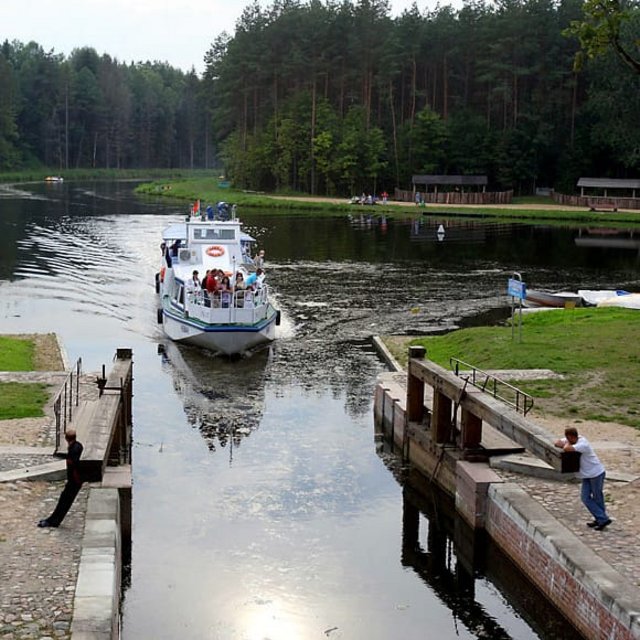Country Belarus
Belarus has few natural resources and in particular lacks coal and iron ore, the basic ingredients of the classic heavy industries. Only potash (potassium carbonate), used in making fertilisers and in glass manufacture, is available in plenty. Thus, in the 19th century – when the country was part of the ... more
ON THE INDUSTRIAL HISTORY OF BELARUS
Belarus has few natural resources and in particular lacks coal and iron ore, the basic ingredients of the classic heavy industries. Only potash (potassium carbonate), used in making fertilisers and in glass manufacture, is available in plenty. Thus, in the 19th century – when the country was part of the Russian Empire – only a few factories were established to process “home-grown” raw materials. The first steam engine was installed in a textile mill in the 1820s, and the subsequent years of the century mainly saw the establishment of saw mills, leatherworking and paper factories.
As in many parts of Russia, greater economic growth did not occur until the abolition of serfdom under Alexander II in 1861 and the construction of the railways. The first railway station was built in Hrodna (Grodno) in the extreme west of Belarus, where the link from St. Petersburg to Warsaw, the capital of Russian “Congress Poland”, intersected the country. This was followed by a branch connecting Daugavpils in then Russian Latvia, with Polotsk and Vitebsk, and finally, in 1872, the line running from Moscow to Warsaw via Brest (formerly Brest-Litovsk). Thus Minsk, too, received its own railway station in 1873.
By World War I, the rail network in Belarus was the most dense in the Czar’s empire, although a dire shortage of capital massively impaired railway construction and industrialisation. The country was dependent on foreign funds and the owners of new businesses, from the electric tram network in Wizebsk to sawmills in Minsk, mostly came from western nations.
World War I was followed by a first phase of independence, but already by 1920 the “Belarus Socialist Soviet Republic” was governed from Moscow. The Soviet Union invested in the reconstruction of plants destroyed in the war, but at the end of the 1920s Belarus was still one of the less-developed republics. Industrial production remained concentrated on foods, wood products and paper. This changed with the first five-year plan in the 1930s. Due to its strategically unfavourable location on the western edge of the Soviet Union and the lack of raw materials, the government did not construct any heavy industrial plants in Belarus, but instead developed the existing industries and expanded the industrial base: new plants now manufactured sewing machines and synthetic fibres, glass and textiles. The harvester factory founded in Homel (Russian Gomel) in 1930 remains in business today.
World War II was a catastrophe that claimed over two million lives and destroyed over 80% of all factories. In the course of reconstruction, Moscow shifted the emphasis from light industry to machinery and metalworking, and the country’s industrialisation was completed. 1946 saw the founding of the tractor works in Minsk, whose Belarus brand tractor remains the country’s most prominent export item. This was followed in 1947 by the automotive manufacturer MAZ, which specialised in heavy trucks for civilian and military use.
New plants were established in the 1950s in particular, and the chemical industry received special emphasis. A synthetics complex was established in the industrial city of Mahilyou (Russian Mogilyov) and a complex for processing potash into fertiliser was constructed in Salihorsk, one of the brand new suburbs, while a gigantic oil refinery was built in Navapolazk. The calculator factory MZVM opened in Minsk in 1958, the very first computer manufacturer in the Soviet Union, which built the unique class of Minsk mainframe computers until 1975. With this broadly diversified and technically sophisticated manufacturing base, Belarus became one of the most important industrial centres of the USSR. Only the Baltic countries boasted a greater gross domestic product. However, the price of this was extreme dependence on the Soviet Union as a supplier of raw materials, particularly coal, oil and iron ore, and as a consumer of finished products, with a significant portion going to the Russian military.

Sites
Baranavichy Railway Engineering Museum
Opanrhkoba 11
225402
Baranavichy, Belarus
Brest Museum of Railway Equipment
Masherava 2
224030
Brest, Belarus
Augustowski Canal
Gorkogo Street 91A
Grodno, Belarus
Orsha Central Station
Central’naya Station
Dzerzhynskogo
211030
Orsha, Belarus
Dudutki Museum Complex of Ancient Crafts and Technologies
222845
Ptick, Belarus






